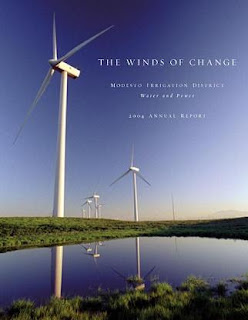The Modesto Irrigation District is gearing up for clean energy in a big way and is closing in on its mandated California renewables requirement.
The small central California utility has built a modern power plant that has the flexibility to support the more sporadic energy generation supplied by the region's wind turbines and solar installations.
"Our projected 2012 green energy mix is 26 percent wind and 2 percent other green resources," says Melissa Williams, MID spokeswoman.
Williams says the "other" category includes Fiscalini Farms’ methane gas digester, which powers the specialty cheesemaker's operation and about 300 homes, and solar.
MID supplies power to an area dominated by Modesto, the largest of its communities with a population of about 201,000. Its service area includes smaller communities of Salida, Empire, Waterford, Mountain House and parts of LaGrange, Riverbank, Ripon, Escalon and Oakdale.
Williams says MID has "actively pursued and procured green energy" to comply with California’s mandated renewable energy portfolio standard of 33 percent renewables by 2020. Other utilities in California, including Pacific Gas & Electric Co., Southern California Edison and Sacramento Metropolitan Utilities District, also are vigorously pursuing the clean energy requirement.
The goal doesn't come easy. Renewable energy to a large degree energizes the electrical grid only when the sun shines or the wind blows. Only hydropower and geothermal can be regulated more like plants fired either by fossil fuels or nuclear fission.
MID built its Woodland 3 Reciprocating Engines Generation Plant with six 20-cylinder Wartsila 34SG units that operate on natural gas. Helsinki, Finland-based Wartsila Corp. says it specializes in technological innovation and efficiency.
Williams says the 49.6 megawatt power plant "provides us with flexible, economical, clean and fast-starting peaking generation to balance and back up our green energy resources like wind and solar." She says the Wartsila engines can run at 50 percent capacity with very little loss of fuel efficiency, and the plant can ramp up half an engine at a time to fill in any gaps in wind and solar generation.
The concept is to ensure adequate power for MID's customers. Williams also says the plant is quiet and that the facility has advanced emission controls and very low water use.
"The Wartsila units will be the backstop for MID, helping us maintain reliable, dependable service to our customers even with the substantial influx of non-traditional, intermittent resources like wind and solar," says Richard Smith, the utility's project manager for the Woodland 3 Project, in a statement.
Williams also notes that her utility's overall 2012 projected power mix includes 10 percent hydro, most of which comes from its Don Pedro powerhouse at Don Pedro Reservoir. The project is shared with the nearby Turlock Irrigation District.
The hydropower doesn’t count as green in California.
There's a big rush in California by solar operators. A recent look at a list supplied by the California Public Utilities Commission shows dozens of installations proposed.
Many come online with very little fanfare. For instance a 45-megawatt plant just opened in Avenal in PG&E territory. And more are coming. The community of Corcoran plans to lease land for a 15 megawatt plant near its waste water treatment plant, for example.
Williams says the economy is playing a role.
"Some are making small energy efficiency home improvements, but with the depreciation of home values many are hesitant to move forward with more expensive energy efficiency measures," she says.
Yet, Williams says MID has seen steady interest in solar and strong commitments from its commercial and industrial customers to make energy efficiency retrofits and pursuing more sustainable policies similar to the model set by leaders like Wal-Mart.
Photo: Courtesy MID 2004 annual report.

No comments:
Post a Comment